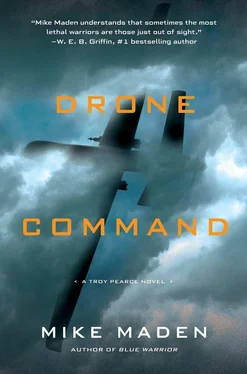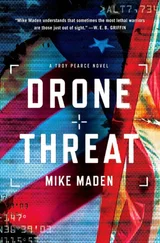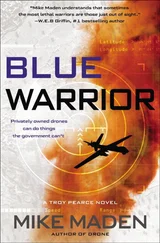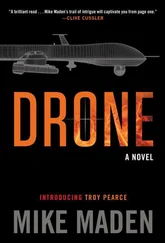“Which only confirms President Myers’s report. The Chinese wouldn’t be this bold if they didn’t possess a fully operational carrier-killing missile,” Onstot said. “The navy sure as hell believes it. Our satellites report that a DF-21D mobile launcher at Ningbo has been prepared and is ready for launch.”
“The Wu-14?” Lane asked.
“Based on what Pearce and Myers described, I would say so.”
“Should we risk sending the George Washington over the red line?”
“The navy says not unless we’re willing to do a preemptive strike on that mobile platform,” Shafer said.
“Which starts the war,” Garza said. “Exactly what we’re trying to avoid.”
“That platform might be a decoy. The real launcher might be somewhere else,” General Onstot said.
The DNI shook his head. “Our intelligence reports indicate no other movement or deployment of mobile launchers outside of Ningbo, something they should’ve done as a decoy move if nothing else. Somebody over there isn’t doing Feng and Ji any favors.”
“Does that mean President Sun is sending us a signal?” Lane asked. The CIA had just confirmed that both Vice Chairman Feng and Admiral Ji were on board the Liaoning.
The secretary of state shook her head. “I’m not sure. Feng and Ji are thick as thieves, and the two of them together pose the greatest threat to Sun’s presidency.”
“You’re saying he’s hoping they’ll go down with the ship?” Lane asked, incredulous.
“He isn’t doing anything extra to prevent that possibility, that’s for sure,” Garza said.
Lane turned back to Pia. “What if we ask the Chinese for a forty-eight-hour delay?”
“To what end? They’re determined to seize the Senkakus even if they granted us another forty-eight hours, which they likely won’t.”
“And if we don’t do anything and allow the Chinese to seize the Senkakus and abandon the Japanese to their fate, all of our other allies in the region — Taiwan, the Philippines, even Australia — will question our commitment to them. They’ll run as fast as they can to Beijing to cut their best deals before the Chinese turn their fleets in their direction,” Wheeler said.
“A complete power realignment throughout the western Pacific. Hell, all of Asia, for that matter,” Shafer added.
“And you’ll embolden the North Koreans for sure,” Pia said.
Onstot leaned forward. “For the record, the navy strongly believes that sending the George Washington over the red line will result in its destruction.”
“So we’re still at square one. Damned if we do, damned if we don’t,” Lane said.
“It’s a lose-lose situation,” Garza said. “A one-handed clap.”
“Almost,” Lane said, leaning back. “There’s still one option.”
His advisors all exchanged a glance, curious. “What have we missed?” Wheeler finally asked.
Lane smiled. “Pearce.”
ON BOARD THE TIGER II NEAR MAO ISLAND
EAST CHINA SEA
19 MAY 2017
09:58 A.M. (JST)
The waters surrounding the Tiger II were a welter of mechanical noise. The grinding metallic acoustics of the incessantly turning drill bit carried for miles beneath the waves, the bit itself driven by enormous diesel engines thrumming on deck like a slow-moving freight train. Enormous thrusters beneath the hull of the giant drillship erupted periodically, churning the sea in a delicate dance choreographed by the finely tuned electronic sensors and blazingly fast computers that kept the forty-five-thousand-ton vessel perfectly positioned in the turgid waters. Without benefit of anchors or fixed assemblies, the automated dynamic-positioning system was the only way to keep the drill assembly perfectly aligned. Otherwise, disaster.
The tired radar operator kept a bleary eye on his scope, trying to stay focused. He crushed another Red Bull can and tossed it in the garbage. It was his third double shift in as many days, midnight to four p.m. Graveyard was the worst. The most exciting thing he ever saw on his scope was the occasional school of fish passing by. He paid little attention to the small blip approaching the rig two hundred meters below the surface. But when the blip reached the spinning drill shaft, he became more interested; most fish didn’t approach the noisy assembly that closely. As the blip rose, it came into underwater-camera range. He smiled. It was a manta ray, its large smooth wings flapping effortlessly in the dark waters below. Apparently, it was curious. He wondered what a manta ray would taste like. Probably like shark, which he favored. Fishing was his passion on the mainland. He wanted to cast a line off the rig’s deck in his off-hours, but the tight-assed captain had forbidden it.
The manta ray passed out of camera range. The sleepy radar operator clucked his tongue in disappointment. Another long shift, boring as hell.
Until the manta ray exploded.
ON BOARD THE SWORD DRAGON
EAST CHINA SEA
19 MAY 2017
09:58 A.M. (JST)
The manta ray was actually a mantabot, another example of beautifully engineered biomimicry. Nature was the best designer and the manta ray was an ideal underwater foil, a graceful swimmer that could carry massive amounts of weight but expended little energy as it glided on its winglike pectoral fins between long, slow, powerful strokes. The mantabot’s pectoral fins were constructed out of highly flexible silicon wrapped around articulating titanium bones, but its main body was an aluminum storage compartment containing onboard electronics, power supply, and payload. In this case, the payload was an electromagnetic pulse (EMP) bomb.
Pearce had earlier deployed the autonomous underwater vehicle from one of the torpedo tubes of Commander Onizuka’s submarine, the Sword Dragon . Swimming virtually undetected until it reached the platform, the mantabot’s stealthiest device was its appearance. Nobody would guess that the familiar shape of the silently swimming batoid was anything other than a manta ray, even as the mantabot breached the surface, an unusual activity for the large fish.
The EMP explosion instantly fried all the electronics on the civilian drillship — computer chips, motherboards, sensors. Every video monitor, camera display, iPod, and chip-based device was immediately taken out of service, including all the computers and sensors powering the automated positioning system keeping the Tiger II in place. Even the massive diesel motors were governed by computers. They shut down as well. The drill bit ground to a halt.
To the scrambling crew, it appeared as if a massive power outage had just occurred. But the automated power-backup systems couldn’t bring the diesel motors or the automated positioning system back on line. Within a few minutes, the churning seas battering the hull of the Tiger II nudged the forty-five-thousand-ton vessel out of alignment, snapping the drill assembly in half. The ship was in deep water; no anchor chain on board could reach the bottom. With no engines online, the ship was now helplessly adrift.
Thanks to his mantabot, Pearce was able to completely shut down the entire drilling operation without firing a shot or shedding a single drop of blood. The Japanese submarine crew shouted triumphantly as Commander Onizuka reported the results. He and Pearce shook hands.
“So far so good,” Onizuka said.
Pearce nodded. “Yeah, but that was the easy part.” He glanced over at Dr. Ashley. She understood.
Even if they managed to pull off the second half of the mission, Pearce doubted they would get out of it alive.
Читать дальше












